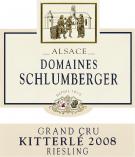History
Ranked among the best wines in the world, the Riesling is one of Alsace’s biggest successes. Introduced in the 15th century, and originating from the Orleanois region, it is different from its German counterpart and from the numerous Riesling which can now be found a little all over the world. A late-ripening grape variety, it continues to ripen at low temperatures, but gives marvelous results when there is a sunny, dry, late summer. First distinguished in 1699, Kitterlé has always had an exceptional reputation. Already protected in the middle ages, it has been sold under its own name since 1830.
Location
This volcanic-sandstone plot is on a unique site, on a steeply sloping rocky outcrop facing three ways (south-west, south and south-east). The light, sandy soil, which is kept back by huge drystone walls, only gives very low yields (25 to 35 hl/ha)
Wine-making
The grapes are hand-picked and whole bunches are pressed. There is static settling of the lees. The wine is fermented in temperature controlled tuns, followed by raising on the less for 8 months.
Gastronomy
- Rock fish
- Mediterranean cuisine
- Bream grilled on one side and candied vegetables tian
- Grilled red mullet and stuffed zucchini flower
Serve at 12°C.
Learn more about food & wine pairingTasting
The robe is a pale golden yellow with hints of silver. The disc is thin and the robe bright and limpid. The robe suggests a young wine.
The nose is at first open and pleasant. I detect a mineral character marked by the smoke and wet stone and exotic scents of citrus fruit zest.
After aeration, the nose expresses the majesty of its terroir. The smoked and ash character is then revealed clearly, along with citrus fruit, particularly lime and yuzu. Subtle notes of dried flowers complement the range. A pleasant nose already very open today.
The first contact with the palate is frank. I discovered an instant and tonic acidity that is the spinal column of the mouth. This tension highlights the notes of lime zest and flesh along with scents of freshly cut aromatic herbs such as the rosemary. It is then followed by an intense mineral register marked by iodized salinity. The length is intense, 6 to 7 caudalies with to a lemony finish. A saline and lively wine, marked by citrus fruit flavours.

















